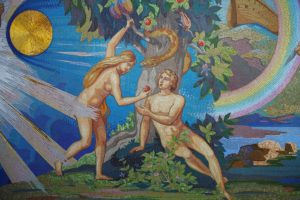
(Scroll down to leave a comment on what makes Christianity a true religion)
We have defined religion from its Latin root as our understanding which “ties or binds together” our thoughts about God. In popular usage religion means the web of beliefs that inform how we understand God. Religion “ties together” how we think about God and how we behave as a consequence. Clearly we must know what “religion” is in order to differentiate the true from the false. Where do we begin?
In his book The Hero with a Thousand Faces,[1] the mythographer Joseph Campbell studied religious “myths” from ancient times to modern, and from cultures all over the world. He identified the recurring themes and the grand story they tell as reported from sacred literature all over the world.
These stories describe a great quest, a search that is rewarded with a bride.
- The hero (a divine man) leaves his father (cf. Hercules, a man awarded immortality).
- He undergoes a road of trials, culminating in a great battle where he slays the dragon to rescue his bride (cf. Hercules strangling the serpents and the trial of his “labors”) .
- He encounters a mystic tree “in the midst” of a sacred wood, where the dead comes alive again (cf. Jason and the Golden Fleece in a tree guarded by a dragon, which he slays).
- The warrior turned lover marries his rescued-beloved (cf. Jason’s rescue of Medea).
- He returns to his father with his bride.
Where does this pattern come from? Do these perennial themes in heroic literature all over the world express the deepest longing of the human heart? If so, do they describe a Champion who is at once a valiant and victorious warrior and also a redeeming and romantic bridegroom? Do they reflect the universal longing for a heroic Kinsman-Redeemer?
Jesus said, “The kingdom of heaven is like a King who prepared a marriage feast for his son” (Matthew 22:2). This parable is the heart of the kingdom claim of Jesus, the foundational understanding of Christianity that presents the original truth from which all other religious myth was derived.

The Story of the Bible presents Jesus, the Seed of the Woman (Genesis 3:15), as the Hero of redemptive history who was to crush the head of the serpent (Genesis 3:15; Revelation 12:1-2, 5).
- Jesus left his Father, according to the pattern of the law (Genesis 2:24) to become flesh, to be made man (John 1:1, 14). Once he was born a man, he came under the law that it is not good for him to be alone (Genesis 2:18). His Father sent him to find and rescue his bride (Matthew 22:2; John 3:29).
- A road of suffering was given to the Hero. That series of trials displayed his sympathetic humanity as well as his divine power. He persevered in such a way as to win the heart of his beloved. There is no hero like him, no rival suitor who could turn the head of his betrothed. But his beloved must be rescued. She was under the lethal power of a draconic or serpentine beast. The Hero had a great battle with the beast in order to win his bride and secure her affections. “The Son of Man must suffer many things and be rejected by the elders and chief priests and scribes, and be killed, and on the third day be raised” (Luke 9:22).
- The cosmic battle took place at a “tree” (The cross is called a “tree,” Galatians 3:13; Colossians 2:14) “in the midst” (John 19:18) of two gardens, Gethsemane and the Garden of the Tomb. The Hero, the Seed of the Woman, sustained a mortal wounding at the tree (Genesis 3:15), but was resurrected in the nearby garden (John 19:41).
- The Hero came as a Bridegroom (Matthew 9:14-15, 25:1-12; John 3:29). He rescued his bride and offered her a betrothal covenant (Heb. ketubah) of salvation (Revelation 19:6-9).
- The Bridegroom returned to his Father, having vanquished his Enemy (Revelation 20:10) and having won his bride (Revelation 21:2-4). The Hero by his victory and by his marriage has reconciled heaven and earth, bringing in everlasting peace (Colossians 1:20; Revelation 21:1).
What was the Task of the Hero Seed of the Woman? (Genesis 3:15)
The Apostle John taught that the Son of God came into the world to destroy the work of the devil (1 John 3:8). How did he do this? According to the prophecy of the Seed of the Woman, he had to destroy the serpent of old and redeem mankind from the sin of disobedience in the Garden of Eden.
Luke presents Jesus as virgin born — the unique Seed of the Woman (Luke 1:34). Matthew also identifies the seed of the serpent. He reports that the Pharisees and Sadducees came to observe the baptism of John. When the Baptist saw them, he spoke in the spirit of prophecy saying, “You brood of vipers!” (seed of the serpent; Matthew 3:7). All the parties to the great drama of redemption were present, and the great battle was to take place in Jerusalem. The religious leaders would strike to kill the Son of Man, but though he would be wounded, it is they who would be crushed.
The Redemption of Jesus Between Two Suppers
Jesus very carefully undoes all that the Enemy had done. We had fallen into disobedience when Eve took the fruit and ate, and gave to her husband and he ate. Then their eyes were opened and they knew their shameful nakedness (Genesis 3:6-7). Mindful of this, the redemptive work of Jesus on the cross was framed by two suppers, the Last Supper and the Supper with the Emmaus Disciples. At the Last Supper, “Jesus took bread and gave it to the disciples and said, “Take, eat, this is my body” (Matthew 26:26). Just as Satan had brought us into sin by eating, so Jesus restored and redeemed us by eating. Jesus took the verbs of our fall and made them the verbs of our redemption. After Jesus’ victory of the cross, the resurrected Christ shared a supper with the two Emmaus disciples. Jesus again “took the bread.” At that moment the disciples recognized Jesus as the resurrected Son of God, and “their eyes were opened, and they knew him (the covering for our shame)” (Luke 24:30-31).
The Redemption of Jesus Between Two Gardens
Jesus’ battle with the Serpent took place in Jerusalem. But the evangelists describe the redemptive suffering of the Savior as taking place in Jerusalem in a manner that recalls Eden. Eden was a garden with two trees in the midst, the Tree of Knowledge and the Tree of Life (Genesis 2:9). In the Gospels, we are told of two gardens, Gethsemane and the Garden of the Tomb, and one tree (the cross) in the midst (John 19:18) of these gardens.
The cross of Jesus recalls the Tree of Knowledge and the disobedience of man that brought death. On the cross, Jesus, who knew no sin, was made sin for us. Acquiring that knowledge of imputed sin, Jesus suffered death. In the emblematic world of the Gospels, the cross is called a tree (Galatians 3:13; Colossians 2:14). To show that Jesus took upon himself the sin and judgment that was due to Adam, all the wounds of Jesus on the cross recall Adam’s judgments. Adam’s sin brought judgment on the ground. Man would work the ground, and by the sweat of his brow he would earn his bread. The same earth would bring forth against him both thorns and thistles (Genesis 3:18-19). Jesus takes these two judgments upon himself when his brow sweats blood in Gethsemane and then when the crown of thorns is pressed down upon the brow of the Savior (Luke 22:44; John 19:2).
Adam sinned by the Tree of Knowledge and so became shamefully naked (Genesis 3:7). The Savior was brought to the Tree of the Cross where he was stripped and so suffered shameful nakedness (Matthew 27:35). Adam was told that his sin would mean that the heel of the Seed of the Woman would be wounded (Genesis 3:15), foretelling the nails of crucifixion that wounded the Savior’s heels (Matthew 27:35). Adam himself suffered a bloody wound in his side in order that the Lord God might give him a bride (Genesis 2:21). Jesus suffered a bloody wound in his side made by a Roman spear, all that he might give life to his bride (John 19:34).[2]
The Redemption of Jesus Reverses the Judgments of Genesis
Jesus suffered the judgment of death that Adam deserved on the Tree of the Cross. For Jesus, it was a tree of cursing (Galatians 3:13) by which he removed the curse against us. The Tree of the Cross was the Tree of Knowledge that brought death to Jesus. But the Tree of the Cross ironically brought forth fruit, the broken body as bread and the outpoured blood as wine. As such, for all who partake by faith of the fruit of the Tree of the Cross, the Cross becomes the Tree of Life!
Adam brought the curse of death upon all, but Jesus came forth from the tomb, bringing life to all (1 Corinthians 15:22). Adam’s sin separated us from the presence of God in the pleasant garden. Jesus came forth from the grave and greeted the Galilean women, having restored the presence of God and mankind in a pleasant garden.
The sin of man increased after Adam, and the world was inundated with the waters of judgment in the days of Noah. But Jesus commissioned his disciples to take the gospel into all the earth, that the world might be covered with the word of God even as the waters cover the sea. The sin of man at Babel brought about the judgment of tongues. Jesus poured out his Spirit on Pentecost and the judgment of tongues began to be reversed.
Through these and many other means, the light is gradually overcoming the darkness and life is overtaking death. The Creator in the beginning is likewise the Redeemer, who will accomplish all things at the end. What a Savior has been given to us!
 Dr. Warren A. Gage, Th.M., J.D., Ph.D. is president of The Alexandrian Forum, which provides life-changing Biblical teaching. To learn more, visit alexandrianforum.org
Dr. Warren A. Gage, Th.M., J.D., Ph.D. is president of The Alexandrian Forum, which provides life-changing Biblical teaching. To learn more, visit alexandrianforum.org
[1] (Princeton Press, 1949).
[2] These are but a few of the emblems of the redemptive work of Jesus. We hope to identify a number of them in our forthcoming book, The Story of the Bible.
Learn more about Gospel Hope in Days of Darkness: goodnewsfl.org/gospel-hope-in-days-of-darkness/

Comments